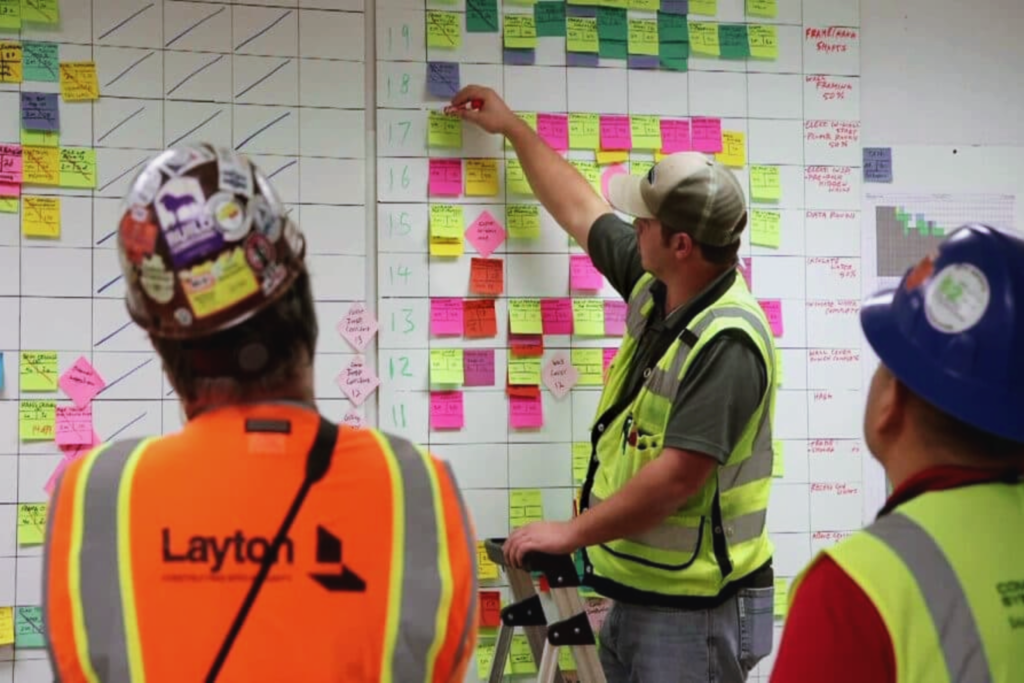Cost and schedule deviations are some of the greatest challenges project managers face—they stem from inefficient scheduling, timeline alterations, and high waste rates.
The solution is lean construction scheduling processes, like the Last Planner® System (LPS) and Scrum. Let’s explore these two methodologies.
What is the Last Planner® System?
Many construction project managers are familiar with the Last Planner® System—it’s a way to collaboratively manage construction projects from design to completion.
As its name suggests, LPS engages the last planners of a project in the planning process to identify and resolve issues, stay on time, and stay on budget.
The Last Planner® System consists of five components:
Free eBook: Quick guide to Lean practices for construction professionals
1. Master scheduling
The master schedule covers all the details of a project from start to finish. Last planners should work together to create this schedule at the onset of each project and refine it as more details come into focus.
It’s the basis for all planning throughout a project that sets milestones, phase durations, and detailed activities of each team.
2. Phase scheduling
Next is a collaborative planning process where the last planners work together to define and sequence each task of a project as defined in the master schedule’s work phases.
This is often done using pull planning techniques, working backward from each milestone to identify its related tasks and conditions for handoff.
3. Lookahead planning
The goal of lookahead planning is to identify and resolve constraints that might prevent construction teams from completing their tasks as planned. This ensures that everyone is ready to start and finish their tasks according to the master schedule.
The key is to not only identify potential constraints before beginning work but also to follow up weekly to check on each team’s progress toward those constraints.

4. Commitment planning
Also called weekly work planning, commitment planning offers teams a way to regularly discuss what’s happening in the project and stay on track with the master schedule, ensuring everyone completes their milestones on time.
Each week, every team should meet to discuss what they’re doing and their commitments during that week. On top of that, each team should touch base daily to ensure that everyone is sticking to the schedule.
Read more: 7 ideas to make implementing lean more successful for your construction projects
5. Learning
Finally, the end goal of LPS—and lean construction in general—is continuous improvement. Immediately after completing a week’s plan, teams should meet to discuss what went well and what did not.
This is a crucial step that helps teams identify the causes of constraints throughout the project and create a plan to either prevent them in the future or plan around them for the rest of the project.
What is the Scrum framework?
Scrum is a methodology used to organize and manage all of the moving parts of a project. While it was originally used in software development, many project managers across all disciplines—including construction—use the Scrum framework.
This methodology works exceptionally well for small teams that must make frequent changes and don’t have static deliverables, making it a great fit for many construction professionals.
Let’s explore the three steps of the Scrum process:
1. Sprint planning
In Scrum, a “sprint” is a specified time period—typically any time between a week and a month. The first step is sprint planning, which is like creating a piece-by-piece master schedule.
During this phase, project managers and their teams should answer two questions:
- What do we need to deliver during this sprint?
- How will we achieve those deliverables?
Also similar to the master schedule, the last planners of the construction project refine the plan periodically as more details become available.
2. Scrum meetings
Following the Scrum methodology means holding a daily meeting with each team to discuss what they’ve achieved, any constraints they’re struggling with, and what work they plan to complete that day.
Everyone involved in the project will update other stakeholders regarding what they’re currently working on and bring up any questions or issues.
These daily scrum meetings are short—teams should expect to spend less than 15 minutes each morning participating in them.
Further reading: What Is Integrated Project Delivery (IPD)?

3. Sprint review
The final Scrum step is when each team gets together after the sprint to review their progress and go over constraints. To improve the next sprint, everyone gathers feedback and discusses what changes they can make in their processes.
The key is reviewing what each team achieved compared to the goals they set during the sprint planning.
As this feedback is gathered and reviewed, the project roadmap and milestones might change when you move on to the next sprint planning session.
Which methodology is best for your project?
The Last Planner® System and Scrum share many similarities—both methodologies take a lean approach to breaking down and refining large pieces of work into more manageable tasks that teams can complete over a reasonable amount of time.
However, the two systems take different approaches and deploy different stages to achieve that goal.
Determining whether LPS or Scrum is better for your project isn’t about one being better than the other. They both share several lean principles of collaboration to help teams deliver better value to their clients.
The successful implementation of either (or both) methodologies relies on project managers choosing the approach that fits within the context, challenges, and people of a project.
Learn more about implementing the right lean processes into your organization with your free copy of the Quick guide to Lean practices for construction professionals.




